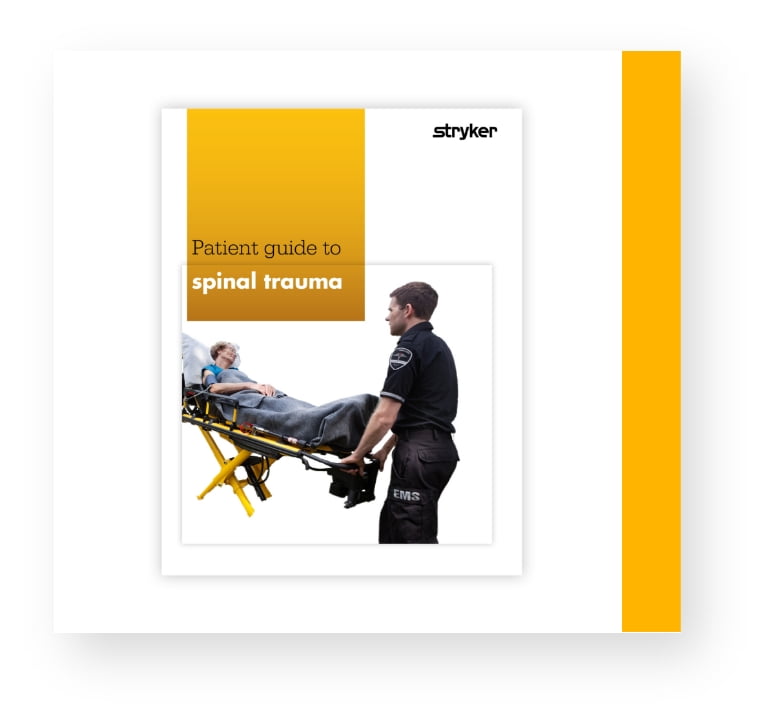Vertebral body fractures
Vertebral body fractures are injuries to the spinal bones that can be caused by osteoporosis, spinal tumors, or trauma and can result in either the gradual or sudden onset of back pain and/or neurological symptoms.
Osteoporosis of the spine
The spinal bones (vertebrae) are particularly vulnerable to osteoporosis – a common condition in which the density and quality of the bones decrease. When bones are compromised by osteoporosis, it may not take much trauma to fracture brittle and weak vertebrae. Even the simple activities of daily living, like bending, coughing, or lifting may put osteoporotic bones at risk.
Spinal tumors
A tumor is a mass of abnormal tissue that can be found anywhere in the body.1 The spinal bones (vertebrae) are a site where tumors can occur in some people.2 Spinal tumors are most commonly secondary, or metastatic, meaning that they originate from a primary tumor elsewhere in the body and spread to the spine through the lymph nodes or bloodstream.3 In addition, spinal tumors can also form in either the vertebrae themselves or from the tissues that form the spinal cord and nervous system; these are known as primary spinal tumors. Occasionally, spinal tumors can become large enough that they put pressure on the spinal cord or nerves. If this happens, a variety of neurological symptoms, such as numbness or weakness in the arms or legs, can develop. Spinal tumors may also cause damage to or even lead to the collapse of one or more vertebral bodies.4 As a result, the tumor may put pressure on the spinal cord or nerves and/or cause pain either at the site or radiating down the arms or legs.2
Trauma
Spinal trauma is another way doctors refer to any injury to the bones, ligaments, or muscles of the spine. It may occur due to low-impact injuries like falling from standing, or from high-impact injuries like motor vehicle accidents or falling from heights. Symptoms may include pain, numbness or tingling in the arms, legs, groin or pelvis, weakness or paralysis in the arms or legs, or in extreme cases, loss of bowel or bladder control.
While some spinal trauma may only cause minor injuries such as a muscle strain or ligament sprain, other spinal trauma may cause significant injuries like fractures or dislocations of the spinal bones (vertebrae). Vertebrae already weakened by osteoporosis can lead to vertebral fractures after even minor injuries or a low level of trauma.
References:
- Cooper GM. “The Development and Causes of Cancer.” The Cell: A Molecular Approach. 2nd edition. Sunderland (MA): Sinauer Associates; 2000.
- Bilsky MH, Lis E, Raizer J, Lee H and Boland P. The Diagnosis and Treatment of Metastatic Spinal Tumor. The Oncologist. Issue 4. 1999. 459-469. Print.
- Maccauro G, Spinelli MS, Mauro S, Perisano C, Graci C and Rosa MA. Physiopathology of Spine Metastasis. International Journal of Surgical Oncology. 2011; 2011: 107969.
- Williams R, Foote M, Deverall H. Strategy in the Surgical Treatment of Primary Spinal Tumors. Global Spine Journal. Volume 2. No. 4. 2012. 249-265. Print.
IMPORTANT INFORMATION ABOUT SPINE SURGERY
Some of the images on this website depict Stryker’s products. Please speak to your doctor if you have questions about these products or anything else in this website.
The information presented is for educational purposes only. Stryker is not dispensing medical advice. Please speak to your doctor to decide if spinal surgery is right for you. Only your doctor can make the medical judgment regarding which products and treatments are right for your own individual condition.
As with any surgery, spinal surgery carries certain risks. Your surgeon will explain all the possible complications of the surgery, as well as side effects. Each spinal surgery patient will experience a different post-operative activity level, depending on his/her own individual clinical factors. Your doctor will help counsel about how to best maintain your activities in order to recover properly from your surgery. Such activities include not engaging in high-impact activities that could de-stabilize any instrumentation that may have been implanted.
Stryker Corporation or its divisions or other corporate affiliated entities own, use or have applied for the following trademarks or service marks: Stryker. All other trademarks are trademarks of their respective owners or holders.
Ask your doctor if spine surgery is right for you.
GEN-WB-24-32016


